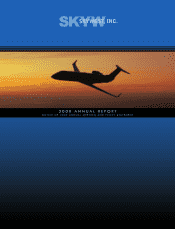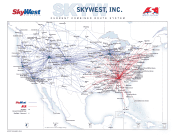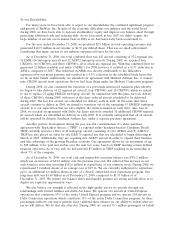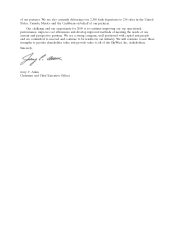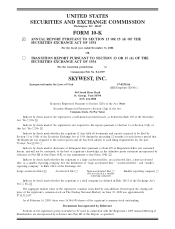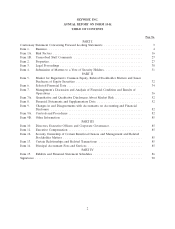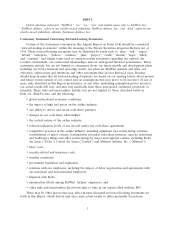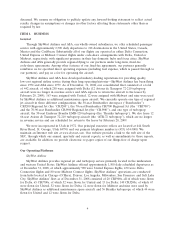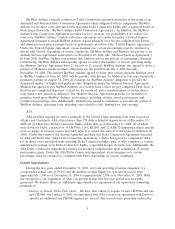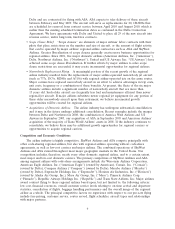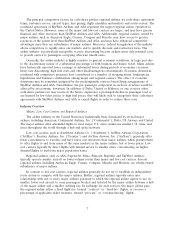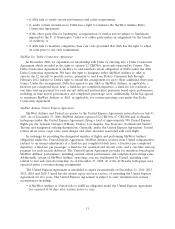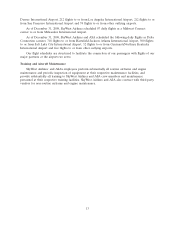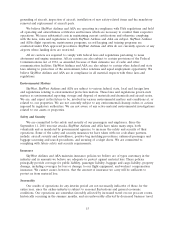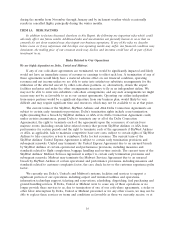SkyWest Airlines 2008 Annual Report Download - page 10
Download and view the complete annual report
Please find page 10 of the 2008 SkyWest Airlines annual report below. You can navigate through the pages in the report by either clicking on the pages listed below, or by using the keyword search tool below to find specific information within the annual report.Delta and are contracted for flying with ASA. ASA expects to take delivery of these aircraft
between February and May 2009. The aircraft will serve as replacements for 20, CRJ200s that
are scheduled for removal from contract service between April 2010 and August 2010, which is
earlier than the existing scheduled termination dates as contained in the Delta Connection
Agreement. We have agreements with Delta and United to place all 29 of the new aircraft into
revenue service, under long-term, fixed-fee contracts.
•Scope Clause Relief. ‘‘Scope clauses’’ are elements of major airlines’ labor contracts with their
pilots that place restrictions on the number and size of aircraft, or the amount of flight activity,
that can be operated by major airlines’ regional airline contractors such as ASA and SkyWest
Airlines. Greater liberalization of scope clauses generally creates more business opportunities for
regional airlines. Since 2001, five major domestic airlines (American Airlines, Inc. (‘‘American’’),
Delta, Northwest Airlines, Inc. (‘‘Northwest’’), United and US Airways, Inc. ‘‘US Airways’’) have
achieved some scope clause liberalization. If further efforts by major airlines to relax scope
clause restrictions are successful, it may create incremental opportunities for regional airlines.
•Narrowbody Replacement Flying. A meaningful portion of the recent growth of the regional
airline industry resulted from the replacement of major airline-operated narrowbody jet aircraft
(such as 737s, DC9s, MD80s and A319s) with regional airline-operated jets on the same routes.
Major carriers have replaced narrowbody aircraft in an effort to achieve advantages in trip costs,
unit costs, frequency or a combination of these benefits. At present, the fleets of the six major
domestic airlines include a significant number of narrowbody aircraft that are more than
15 years old. Such older aircraft are frequently less fuel and maintenance efficient than newer
regional jet aircraft. If major airlines substitute newer regional jet equipment for any portion of
these older narrowbody aircraft upon their retirement, we believe incremental growth
opportunities will be created for regional airlines.
•Acquisitions of Domestic Airlines. The airline industry has undergone substantial consolidation,
and it may in the future undergo additional consolidation. Recent examples include the merger
between Delta and Northwest in 2008, the combination of America West Airlines and US
Airways in September 2005, our acquisition of ASA in September 2005 and American Airlines’
acquisition of the majority of Trans World Airlines’ assets in 2001. If the industry continues to
consolidate, we believe there may be additional growth opportunities for regional carriers or
opportunities to acquire regional carriers.
Competition and Economic Conditions
The airline industry is highly competitive. SkyWest Airlines and ASA compete principally with
other code-sharing regional airlines, but also with regional airlines operating without code-share
agreements, as well as low-cost carriers and major airlines. The combined operations of SkyWest
Airlines and ASA extend throughout most major geographic markets in the United States. Our
competition includes, therefore, nearly every other domestic regional airline, and to a certain extent,
most major and low-cost domestic carriers. The primary competitors of SkyWest Airlines and ASA
among regional airlines with code-share arrangements include Air Wisconsin Airlines Corporation,
American Eagle Airlines, Inc. (‘‘American Eagle’’) (owned by American), Comair, Inc. (‘‘Comair’’)
(owned by Delta), Compass Airlines (‘‘Compass’’) (owned by Delta), Mesaba Airlines (‘‘Mesaba’’)
(owned by Delta), ExpressJet Holdings, Inc. (‘‘ExpressJet’’), Horizon Air Industries, Inc. (‘‘Horizon’’)
(owned by Alaska Air Group, Inc.), Mesa Air Group, Inc. (‘‘Mesa’’), Pinnacle Airlines Corp.
(‘‘Pinnacle’’), Republic Airways Holdings Inc. (‘‘Republic’’) and Trans State Airlines, Inc. Major airlines
award contract flying to these regional airlines based upon, but not limited to, the following criteria:
low cost, financial resources, overall customer service levels relating to on-time arrival and departure
statistics, cancellation of flights, baggage handling performance and the overall image of the regional
airline as a whole. The principal competitive factors we experience with respect to our pro-rate flying
include fare pricing, customer service, routes served, flight schedules, aircraft types and relationships
with major partners.
6

